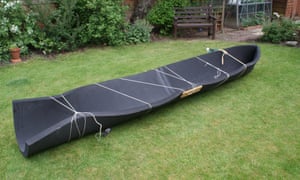When did you last build a boat? Maybe that seems an outlandish concept – something for Noah, for loftsmen, for bearded woodsmen, not for you.
But go back 50 years, and you will find lots of normal people built boats. The Mirror dinghy was a plywood DIY project conceived by the Daily Mirror newspaper in the 1960s, to bring sailing to the masses. Boat building was a family pastime, a fun thing for a Saturday, and achievable with little experience, basic equipment and materials.
Not only are they fun, but boats are useful. You can take advantage of Britain’s 3,541km of waterways. Revolutionise your commute. Escape a flood.
Even if the floods aren’t coming, retired engineer Jim Flood, creator of the Openboat project, has plans for you. Flood has designed a rowing boat you can make yourself from a sheet of plastazote (camping mat material) and four strips of softwood. The total cost is around £100 (a fibreglass model would set you back a couple of thousand). He has tested his design, checked it is water-worthy, and given away the instructions for free on his website (alongside instructions for making a wooden rowing machine, a canoe, and a kayak).
https://youtube.com/watch?v=EUo9nUU3aUA%3Fwmode%3Dopaque%26feature%3Doembed
https://youtube.com/watch?v=EeqrqSwf3Pg%3Fwmode%3Dopaque%26feature%3Doembed
Flood’s motive runs deeper than just getting more Guardian readers into boats, though. After he retired, he trained as a rowing coach and discovered that rowing has a problem. It’s an incredibly expensive sport, and it costs a fortune to ship fibreglass rowing boats out to poorer countries with no rowing boat industry of their own. When the boats get damaged it costs a fortune to replace the parts. Often, damaged rowing boats in African or South American countries end up covered in patches, battered and abandoned. Young sportspeople in developing countries aren’t pursuing rowing in significant numbers – but why would they when the sport is so richly funded elsewhere? They don’t stand a chance.
The problem for rowing is that if poorer countries aren’t able to take part, the sport risks its place at the Olympics.
For an engineer with a creative spirit, a problem is an opportunity. Flood already had experience as an innovator (“not an inventor. I’m not coming up with something new, I’m taking something and improving it.”) He’d had two ideas on the BBC science programme Tomorrow’s World, including a rice-powered flag on a timer for Filipino lobster pots.
The answer to the rowing boat problem, thought Flood, was to make rowing boats widely available, and the best way to do that was by allowing people to build their own. So the plastazote model was born, using cheap, waterproof materials which are widely available around the world.

Flood is eager for rowers in developing countries to adopt the new plastazote boats; so that they can become as ferociously competitive at rowing as those in European countries, and so that everyone can enjoy rowing in the Olympics for decades to come.
It’s also a way for people to reconnect with making things. “I wanted something that families could make together and have fun with,” says Flood. “Not just going to the supermarket and buying a canoe off the shelf, but getting involved.
“People used to make canoes out of strips of canvas. Today, with shop-bought boats, there is very little you can do. You can’t tinker with the exotic material or design. We are losing our connection with technology.”
Anyone can help Flood’s mission by building a boat of their own. “The aspirations of people in developing countries is to want what we’ve got,” says Flood. “My additional aim is to get these boats made over here to show that British people are using these, Dutch people are using them, German people are using them. Then everyone will want one.”
Source: Read Full Article
